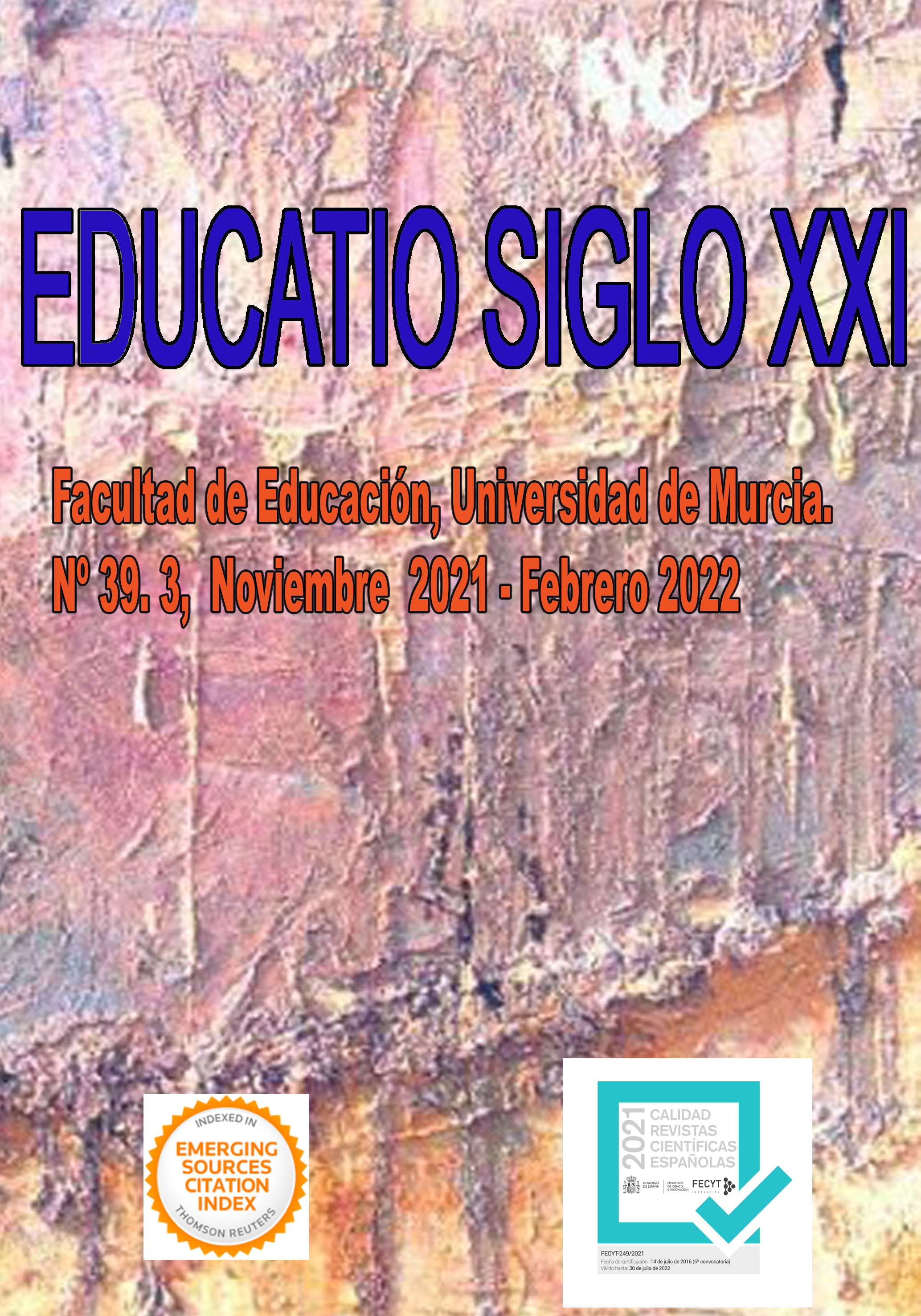Mobile phones, social networks and digital praxis in adolescents
Abstract
The association of mobile phones and social networks during adolescence surpasses technological considerations. These practices, while extremely common and ubiquitous in adolescents’ daily lives, are relatively invisible to teachers and families. It is, therefore, necessary to establish a roadmap in the design of educational proposals enhanced by mobile technologies. Through a quantitative longitudinal descriptive study, levels of use and behavior with mobile phones are identified in a sample (N=645) of Secondary School and Baccalaureate students. Special attention, which we disaggregate by gender and education level, is paid to the most commonly used apps and to time of use. Results show that the mobile phone is not only identified as an information storage system, but it is also used for a communicative purpose (social media) which is supported by image editing applications (photography-video) and audiovisual consumption (videos- music). In the second year of Secondary Education there is an increase in the use of apps and in the time spent using mobile phones. There are significant differences in relation to gender in the use of social media, being the value of the image an axiomatic point in this difference. Results show the threats inherent in the use of mobile phones and highlight the challenges when it comes to designing an ambitious praxis of digital literacy that contemplates responsible uses of social media, highly informed knowledge of digital content and the introduction of multimodal communication scenarios that favour sharing creative processes.
Downloads
-
Abstract4467
-
PDF (Español (España))2062
References
Ballesta, J,; Lozano, J.; Cerezo, Mª. C.; Soriano, E. (2014). Internet, redes sociales y adolescencia: un estudio en centros de educación secundaria de la región de Murcia. Revista Fuentes, 16, 109-130. http://dx.doi.org/10.12795/revistafuentes.2015.i16.05
Campos Freire, F. (2008). Las redes sociales trastocan los modelos de los medios de comunicación tradicionales. Revista Latina de Comunicación Social, 63, 287-293. https://doi.org/10.4185/RLCS-63-2008-767-287-293
Calvo, S. y San Fabián, J.L. (2018). Redes Sociales y Socialización Afectiva de las Personas Jóvenes: Necesidades Docentes en Educación Secundaria Obligatoria. Revista Iberoamericana sobre Calidad, Eficacia y Cambio en Educación, 16(2)mar. http://dx.doi.org/10.15366/reice2018.16.2.001.
Carli, V., Durkee, T., Wasserman, D., Hadlaczky, G., Despalins, R., Kramarz, E., Wasserman, C., Sarchiapone, M., Hoven, C. W.,
Brunner, R. y Kaess, M. (2013). The Association between Pathological Internet Use and Comorbid Psychopathology: A Systematic Review. Psychopathology, 46, 1-13. https://doi.org/10.1159/000337971
Casale, S., Fioravanti, G. y Rugai, L. (2016). Grandiose and Vulnerable Narcissists: Who Is at Higher Risk for Social Networking Addiction?. Cyberpsychology, behavior and social networking. 19. 510-515. https://doi.org/10.1089/cyber.2016.0189
Castells, M. (2001). La galaxia Internet. Reflexiones sobre Internet, empresas y sociedad. Barcelona, Arete.
Colás-Bravo, P., González, T. & de Pablos, J. (2013). Young People and Social Networks: Motivations and Preferred Uses. [Juventud y redes sociales: Motivaciones y usos preferentes]. Comunicar, 40, 15-23. https://doi.org/10.3916/C40-2013-02-01.
Comunidad de Madrid (2019). Servicio de atención en adicciones tecnológicas. https://tinyurl.com/wn3qlyc
Ditrendia (2019): Informe Ditrendia: Mobile en España y en el Mundo. Madrid: Ditrendia Digital Marketing Trends. Recuperado de https://tinyurl.com/tvhstc4
Fernández Rodríguez, E. y Gutiérrez Pequeño, J. M. (2017). La socialización de los jóvenes interconectados: Experimentando la identidad en la sociedad aumentada. Profesorado. Revista de Currículum y Formación de Profesorado, 21(2), 171-190. https://tinyurl.com/vns83l4
Fernández, J., Peñalba, M. A. e Irazabal, I. (2015). Hábitos de uso y conductas de riesgo en Internet en la preadolescencia. [Hábitos de uso y conductas de riesgo en Internet en la preadolescencia] Comunicar, 44, 113-120. https://doi.org/10.3916/C44-2015-12
García, E. y Heredia, N. (2017). Emociones y redes sociales en adolescentes, Revista de estudios e investigación en Psicología y Educación, 13. https://doi.org/10.17979/reipe.2017.0.13.2131
García-Jiménez, A., López de Ayala, M.C. & Catalina, B. (2013). The Influence of Social Networks on the Adolescents’ Online Practices. [Hábitos de uso en Internet y en las redes sociales de los adolescentes españoles]. Comunicar, 41, 195-204. https://doi.org/10.3916/C41-2013-19.
Gee, J., y Hayes, E. (2012). Nurturing Affinity Spaces and Game-based Learning. En C. Steinkuehler, K. Squire, & S. Barab (Eds.), Games, Learning, and Society: Learning and Meaning in the Digital Age (pp. 129-153). Cambridge: Cambridge University Press.
Gialamas, V., Nikolopouiou, K. y Kutromanos, G. (2013). Student teachers’ perceptions about the im pact of Internet usage on their learning and Jobs. Computers & Education, 62, 1-7. https://doi.org/10.1016/j.compedu.2012.10.012
González, E., & Martínez, N. (2018). Redes sociales como factor incidente en el área social, personal y académica de alumnos de Educación Secundaria Obligatoria. Tendencias Pedagógicas, 32, 133-146. http://dx.doi.org/10.15366/tp2018.32.010
Hernández-Hernández, (2019). La perspectiva post-cualitativa y la posibilidad de pensar en ‘otra’ investigación educativa. Educatio Siglo XXI, 37(2), 11-20. https://doi.org/10.6018/educatio.386981
Herrera Harfuch, M. F., Pacheco Murguía, M. P., Palomar Lever, J. y Zavala Andrade, D. (2010). La acción a Facebook relacionada con la baja autoestima, la depresión y la falta de habilidades sociales. Psicología Iberoamericana, 18(1), 6-18. https://doi.org/10.17979/reipe.2017.0.13.2131
IAB Spain (2019). Estudio anual de redes sociales 2019. https://tinyurl.com/vx5w8uc
Instituto Nacional de Estadística (2019). Población que usa internet. https://tinyurl.com/tsplhs2
Lareki, A., Martínez de Morentín, J. I., Altuna, J. y Amenábar, N. (2017). Teenagers' perception of risk behaviors regarding digital technologies. Computers in Human Behavior, 68, 395-402. https://doi.org/10.1016/j.chb.2016.12.004.
Li, W., Garland, E. L. y Howard, M. O. (2014). Family factors in Internet addiction among Chinese youth: A review of English- and Chinese-language studies, Computers in Human Behavior, 31, 393-411. https://doi.org/10.1016/j.chb.2013.11.004
Malo-Cerrato, S., Martín-Perpiñá, M. & Viñas-Poch, F. (2018). Excessive use of social networks: Psychosocial profile of Spanish adolescents. [Uso excesivo de redes sociales: Perfil psicosocial de adolescentes españoles]. Comunicar, 56, 101-110. https://doi.org/10.3916/C56-2018-10
Mateo, J. (2012). La investigación ex post-facto. En R. Bisquerra (Coord.), Metodología de investigación educativa (195-229). Madrid: La Muralla. https://tinyurl.com/suwm8p5
Mazzoni, E., Baiocco, L., Cannata, D. y Dimas, I. (2016). Is internet the cherry on top or a crutch? Offline social support as moderator of the outcomes of online social support on Problematic Internet Use, Computers in Human Behavior, 56, 369-374. https://doi.org/10.1016/j.chb.2015.11.032
Menezes M., Arvanitidis P., Smaniotto Costa C., Weinstein Z. (2019) Teenagers’ Perception of Public Spaces and Their Practices in ICTs Uses. In: Smaniotto Costa C. et al. (eds) CyberParks – The Interface Between People, Places and Technology. vol 11380. Springer, Cham.
Merino Malillos, L. (2011). Jóvenes en redes sociales: significados y prácticas de una sociabilidad digital. Revista de Estudios de Juventud (95), 31-43. https://tinyurl.com/ukta4ts
Morduchowicz, R. (2012). Los adolescentes y las redes sociales: la construcción de la identidad juvenil en Internet, Buenos Aires, Fondo de Cultura Económica.
Müller, K. W., Dreier, M., Beutel, M. E., Duven, E., Giralt, S. y Wölfing, K. (2016). A hidden type of internet addiction? Intense and addictive use of social networking sites in adolescents, Computers in Human Behavior, 55, 172-177. https://doi.org/10.1016/j.chb.2015.09.007
Pink, S.; Horst, H.; Postill, J.; Hjorth, L.: Lewis, T. and Tacchi, J. (2016). Digital Etnography. Principles and practice. London:Sage.
Przybylski, A., Murayama, K., De Haan, C. R. y Gladwell, V. (2013), Motivational, emotional, and behavioral correlates of fear of missing out, Computers in Human Behavior, 29(4), 1841-1848. https://doi.org/10.1016/j.chb.2013.02.014
Reig, D. (2012). Socionomía. ¿Vas a perderte la revolución social?, Barcelona, Ediciones Deusto.
Rojas-Jara, C., Henríquez, F., Sanhueza, F., Núñez, P., Inostroza, E., Solís A. y Contreras, D. (2018). Adicción a Internet y uso de redes sociales en adolescentes: una revisión. Revista española de drogodependencias, 43(4), 39-54. https://tinyurl.com/s9kdyb4
Rubio-Romero, J., Jiménez, J. M. y Barón-Dulce, G. (2019). Las redes sociales digitales como espacios de sociabilidad de los adolescentes. El caso del colegio Escolapios de Aluche. Revista Mediterránea de Comunicación. 10(2), 85-99. https://www.doi.org/10.14198/MEDCOM2019.10.2.19
Tejada Garitan, E., Castaño Garrido, C. y Romero Andonegui, A. (2019). Los hábitos de uso en las redes sociales de los preadolescentes. RIED. Revista Iberoamericana de Educación a Distancia, 22(2), 119-133 https://doi.org/10.5944/ried.22.2.23245
Tsitsika, A., Tzavela, E. y Mavromatí, F. (2013). Research on Internet Addictive Behaviours among European Adolescents, Athens: EU NET ADB Project. https://tinyurl.com/wf7vthj
Vega-Almeida, R. L.; Arencibia-Jorge, R. (2019). El lado oscuro de Internet: un estudio bibliométrico de la literatura sobre comportamientos adictivos en línea. Revista Española de Documentación Científica, 42(4), e251. https://doi.org/10.3989/redc.2019.4.S8
Vernon, L., Barber, B. L. y Modecki, K. L. (2015). Adolescent Problematic Social Networking and School Experiences: The Mediating Effects of Sleep Disruptions and Sleep Quality, Cyberpsychology, Behavior and Social Networking, 18(7), 386-392. https://doi.org/10.1089/cyber.2015.0107
Wang, J. L., Gaskin, J., Wang, H. y Liu, D. (2016). Life satisfaction moderates the associations between motives and excessive social networking site usage, Addiction Research & Theory, 24(6), 450-457. https://doi.org/10.3109/16066359.2016.1160283
We are social (1 febrero, 2019). Digital in 2019 España [Mensaje en un blog]. https://tinyurl.com/yxvs3oa9
Winocur, R. (2006). Internet en la vida cotidiana de los jóvenes. Revista Mexicana de Sociología, 68(3), 551-580. http://dx.doi.org/10.22201/iis.01882503p.2006.003.6069
Copyright (c) 2021 Servicio de Publicaciones de la Universidad de Murcia

This work is licensed under a Creative Commons Attribution-NonCommercial-NoDerivatives 4.0 International License.
Original work publishes in this journal is subject to the following terms:
1. Murcia University Press (the publishing house) holds the copyright of the publishes work, and favours and allows their reutilization under the use license stated in point 2.
© Servicio de Publicaciones, Universidad de Murcia, 2015
2. Work is published in the electronic edition under a license (Creative Commons Reconocimiento-NoComercial-SinObraDerivada 4.0 España (legal text). They can be copied, used, disseminated, transmitted and publicly presented, as long as: i) authorship and original publication source is acknowledged (journal, publishing house and URL of the work); ii) are not used for commercial purposes; iii) the existence and specifications of this use license is stated.
3. Conditions for self-archive. Authors are allowed and encouraged to disseminate electronically the pre-pint (before review) and/or post-print (accepted for publication) versions of their work before their publication since that favours earlier circulation and dissemination resulting in an increased chance for the authors to be cited and for the work to reach a bigger share of the academic community. Colour: RoMEO: green.







